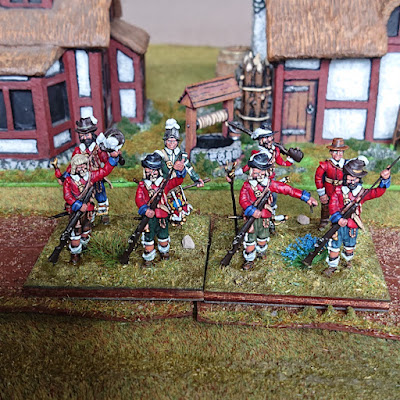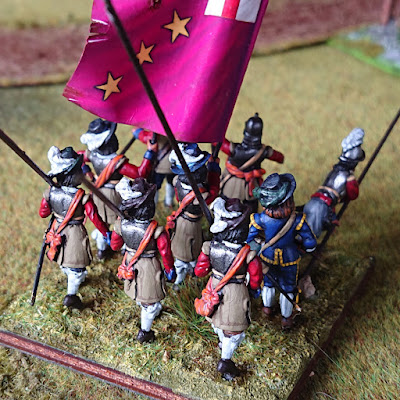On Wednesday I hosted a C&C miniatures game - the Battle of Orthez. The plan was to play this as a 4-handed game, but sadly Stryker was unable to join us, because of illness in his family, so Goya commanded all the Allies, and The Archduke and I had the French.
A crowded field - lots of troops, and rather busy terrain - the scenario was basically the "Epic" game taken from the C&C user site, scaled down a bit for troop numbers and physical size to fit my 17 x 9 hex table.
As ever, the game was enjoyable, though the action developed rather slower than usual, no doubt because of the complexity of the terrain, and we did not finish. The official Victory Point requirement for the win was 12 points (which included some points for possession of built-up areas and hills), and we were at 10-9 to the Allies at the point where we had to adjourn to get some dinner and allow Goya to get his train! In fairness (as ever), I think that if this had been the historical end to the action then Soult would have been obliged to retreat (again).

My camera was giving me some problems on Wednesday, so there are less photos than usual; here is the view from behind the French left flank, early on. The French army finds itself in an unfamiliar situation for the Peninsular War, defending a ridge position. The town of Orthez is top centre; the pale green counters on the edge of the board indicate where the French reserves may appear later - the bad news for the French is that the reserves are very poor conscripts, rated as "Militia" for C&C purposes, which means they are disadvantaged in melee combat, and potentially suffer triple retreats!
Here we are behind the French right (which was my view for the day). In the foreground is the village of St Boès, and beyond it the walled churchyard, where the 25ème Léger held out for most of the day
On the Allied right, two regiments of Light Dragoons (correct 1814-vintage chaps in shakoes, kindly supplied by Goya) splash through the fords across the river (Gave de Pau, which nowadays seems to have mysteriously become the River Ousse) and force some of Harispe's infantry into square. The French cavalry obligingly shifted out of the way and left the infantry to get on with it! This was a nasty affair - the fighting here reduced all the units involved to a poor state - the French cavalry did appear later to see off the Light Dragoons...
On their left, the Allies seemed intent on attacking through the woods, Viet-Cong style. I think some work on the C&C house rules is required for our next game here - otherwise I may be turning up with an army of elephants, for old times' sake
The Allies focused on Orthez and the churchyard, and their delay in attacking the centre gave the French time to develop their field artillery on the hills, which rather put paid to any major attack in that area subsequently
Harispe's boys working hard to hold Orthez - they lost part of it for a while, but took it back. The bridge over the river is blocked and may not be used, though the Allied artillery was a nuisance firing across the river
Rouget, in the centre of the French line, waiting for an attack which never came
After a prolonged struggle, the Allies took the churchyard - here the Brunswickers, from Walker's 7th Division, get the job of holding it
Near the end of the day, Taupin's Division, who as far as I recall never shot anyone, are still in position at St Boès, though they are no longer supporting the churchyard to their front. If the game had continued, things would probably have got more difficult for them
My thanks to Goya and the Archduke for their excellent company and the chat, for very kindly buying dinner (which was definitely not in the script!) and for making the trip for what was a terrific day.
Rules Observations
Some years ago (Oct 2018) I was disappointed in my attempt to produce a decent scenario for Eggmühl, since the C&C rules made it almost impossible for French troops to attack the big Austrian battalions in wooded country - the Austrians just shot them when they came in range. Subsequently I decided that the "Ranged Combat" effect of muskets needed some adjustment, and I added this to some experimental changes to introduce a dice-based activation system, replacing the Command Cards, to produce my own house-variant C&C game, Ramekin, which has served me well for a while now.
This week's game was excellent fun, but I fear that, in a fiddly terrain, one of the reasons we got a bit bogged down was exactly because ranged musketry was not effective enough, the game was dominated by artillery fire and melee combat (which is probably quite authentic for this battle) and the individual game turns were quite long.
I was left with a feeling that I would like to try the original C&C again - cards and all - and restore the Ranged Combat rules to their former strength. One feature of the original game is that the individual turns are short, but there are lots of them - I'd like to try that again. There is also a possibility that my rules have unwittingly pushed the game away from what the Real Guys would describe as "the true period flavour" [God help us].





















